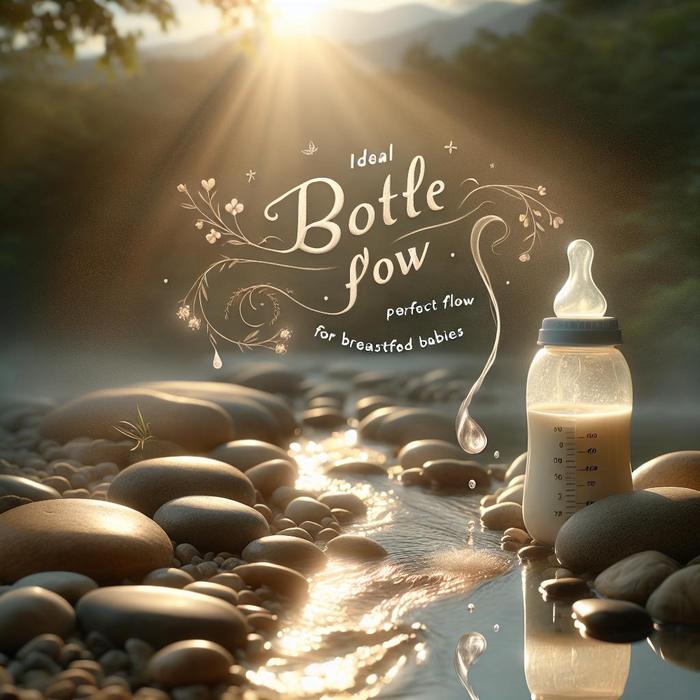Understanding the Ideal Bottle Flow for Breastfed Babies
When it comes to feeding your breastfed baby, finding the perfect flow is crucial. Not all bottles are created equal. Each is designed with different flow rates to suit babies at various stages of development. So, how do you determine the best bottle flow for your little one? Let’s delve into this important aspect of bottle feeding.
What is Bottle Flow?
Bottle flow refers to the speed at which milk is released from the baby’s bottle. This depends on the design and size of the nipple hole. As a general rule, slower flow rates are better for newborns, while older babies can handle faster flows.
Importance of Choosing the Perfect Flow
Choosing the right bottle flow for your breastfed baby is important for several reasons:
- Prevent Overfeeding: A bottle with a flow rate that’s too high could lead to overeating. This is because babies find it hard to control the milk’s speed, leading to more intake than necessary.
- Reduce Gas and Colic: Slow-flow bottles reduce the amount of air swallowed during feeding, which can cause discomfort and gas.
- Avoid Nipple Confusion: Breastfed babies are used to a certain flow rate from the breast. A similar flow rate from the bottle can make the transition between breast and bottle smoother.
Finding the Best Bottle Flow
While it might seem daunting to find the best slow flow bottles for breastfed babies, a little knowledge can go a long way. Here’s what you should consider:
- Age of the Baby: Newborns typically do best with slow flow nipples, while older babies can handle medium to fast flow. Remember, however, that each baby is unique and there is no hard and fast rule. The best nipple for your baby depends on their comfort and feeding patterns.
- Baby’s Behavior: If your baby is choking, coughing, or gulping loudly during feeding, it’s a sign that the flow might be too fast. On the other end of the spectrum, frustration or falling asleep might suggest the flow is too slow.
- Transition from Breast to Bottle: For babies transitioning from breast to bottle, mimicking the flow of the breast can help. Refer to our guide for a smoother transition.
Try and Test
Ultimately, finding the ideal bottle flow will require some trial and error. Every baby is different, and what works for one might not work for another. Be prepared to try different bottles and nipples to find the one that suits your baby the best. The best bottles for breastfed babies are often those that mimic the natural flow of the breast.
A Word on Bottle-Feeding and Breastfeeding Balance
Maintaining a balance between breastfeeding and bottle-feeding can be challenging. It’s essential to remember that while the bottle offers convenience, the breast provides numerous health benefits for both the mother and baby. Visit our post on balancing breastfeeding and bottle-feeding for more information.
Understanding Different Bottle Types
With so many varieties of baby bottles in the market, making the right choice can be overwhelming. Pasifiers with slow, medium and fast flow rates, angled and straight bottles, vented or non-vented options, each type offers its perks and insights.
Crux of Bottle Flow
Another crucial factor to navigate when considering bottle flow rates is the size and number of holes in the baby bottle nipple. This will dictate the speed at which the milk exits. For instance, Dr. Brown’s nipple level guide offers a detailed guide on how their different nipple levels cater to varying age groups and feeding types.
Tools to Aid
Tools like the flow rate cards, can be beneficial in identifying the ideal flow rate for your baby’s bottle.
Appropriate Bottle Flow for Breastfed Babies
Getting the right flow for a baby transitioning from breast to bottle is crucial. The baby is accustomed to controlling the flow during breastfeeding, and plunging them into a fast flow bottle might result in choking or overeating. In this regard, slow flow bottles are typically recommended for breastfed babies. A slower flow mimics the natural breastfeeding rhythm, making the transition to bottle feeding smoother.
A Baby’s Reaction is Key
While selecting the right bottle flow, knowing what to look for goes a long way. Your baby’s reaction during feeding times can offer ample information about the suitability of the bottle flow. For example, if a baby is gulping or coughing during feeding, it may show that the flow is too fast for them to handle. On the other hand, if the baby is sucking hard or getting frustrated during feeding, this could signify that the flow is too slow.
Experimentation is Key
Often, finding the ideal bottle flow involves multiple trials and tests. Remember, every baby is unique, so what works for one might not work for another. Continue experimenting with different types of bottles until you find one that suits your baby perfectly.
Switching Between Breastfeeding and Bottle Feeding
Mixing breastfeeding with bottle feeding can present challenges. Keeping a balanced approach is critical. It’s crucial to remember that while bottle feeding offers convenience, breastfeeding offers unique health benefits not just to the baby but also to the mother. Be sure to check this helpful guide on alternating breastfeeding and bottle feeding.

